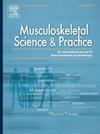枕下肌肉的形态特征和变化:一项尸体研究。
IF 2.2
3区 医学
Q1 REHABILITATION
引用次数: 0
摘要
背景:枕下肌复合体对上颈椎生物力学和本体感觉的头部姿势调节有重要作用;然而,其解剖学变异的全面形态特征和流行程度仍然不明确。目的:本研究旨在评估枕下肌肉的形态特征和变化,评估其对称性,并确定具有潜在临床意义的解剖变异的普遍性。设计:横断面尸体研究。方法:对27具尸体头部进行了福尔马林-乙醇-苯酚溶液保存研究。解剖枕下肌,显露解剖结构。使用数字卡尺进行形态测量。对每一块肌肉的左右两侧对称性进行分析。解剖变异的存在,如双裂结构、副纤维和寰乳突肌被记录下来。结果:11.11%的尸体出现双侧RCPmi变异,3.7%的尸体出现单侧OCi变异。11.11%的标本存在寰乳突肌。左右两侧肌肉形态计量数据无显著差异;都是对称的。在OCs中未观察到变化。结论:这项研究为枕下肌变异的流行提供了重要的解剖学见解,特别是在RCPmi和RCPma中,这可能影响临床手术,如干针和肌电图(EMG)。研究结果强调了解剖学知识在预防手术并发症中的重要性。未来需要更大样本量的研究和功能分析来进一步探索这些变异的临床影响。本文章由计算机程序翻译,如有差异,请以英文原文为准。
Morphometric characteristics and variations of the suboccipital muscles: A cadaveric study
Background
The suboccipital muscle complex critically contributes to upper cervical biomechanics and proprioceptive regulation of head posture; however, the comprehensive morphometric characterization and prevalence of its anatomical variants remain poorly defined.
Objectives
This study aimed to evaluate the morphometric characteristics and variations of the suboccipital muscles, assess their symmetry, and determine prevalence of anatomical variations with potential clinical significance.
Design
A cross-sectional cadaveric study.
Method
This study was conducted on 27 cadaveric heads preserved in formalin-alcohol-phenol solution. The suboccipital muscles were dissected to expose the anatomical structures. Morphometric measurements were performed using a digital caliper. Symmetry between the left and right sides was analyzed for each muscle. The presence of anatomical variations such as bifid structures, accessory fibers, and atlantomastoid muscles was recorded.
Results
Bilateral variations in RCPmi were observed in 11.11 % of the cadavers, while a unilateral variation in OCi was identified in 3.7 % of cases. The atlantomastoid muscle was present in 11.11 % of the specimens. No significant differences were observed in the morphometric data of the muscles on the right and left sides; all were symmetrical. No variations were observed in OCs.
Conclusions
This study provides essential anatomical insights into the prevalence of suboccipital muscle variations, particularly in RCPmi and RCPma, which could influence clinical procedures such as dry needling and electromyography (EMG). The findings emphasize the importance of anatomical knowledge in preventing procedural complications. Future studies with larger sample sizes and functional analyses are needed to further explore the clinical impact of these variations.
求助全文
通过发布文献求助,成功后即可免费获取论文全文。
去求助
来源期刊

Musculoskeletal Science and Practice
Health Professions-Physical Therapy, Sports Therapy and Rehabilitation
CiteScore
4.10
自引率
8.70%
发文量
152
审稿时长
48 days
期刊介绍:
Musculoskeletal Science & Practice, international journal of musculoskeletal physiotherapy, is a peer-reviewed international journal (previously Manual Therapy), publishing high quality original research, review and Masterclass articles that contribute to improving the clinical understanding of appropriate care processes for musculoskeletal disorders. The journal publishes articles that influence or add to the body of evidence on diagnostic and therapeutic processes, patient centered care, guidelines for musculoskeletal therapeutics and theoretical models that support developments in assessment, diagnosis, clinical reasoning and interventions.
 求助内容:
求助内容: 应助结果提醒方式:
应助结果提醒方式:


